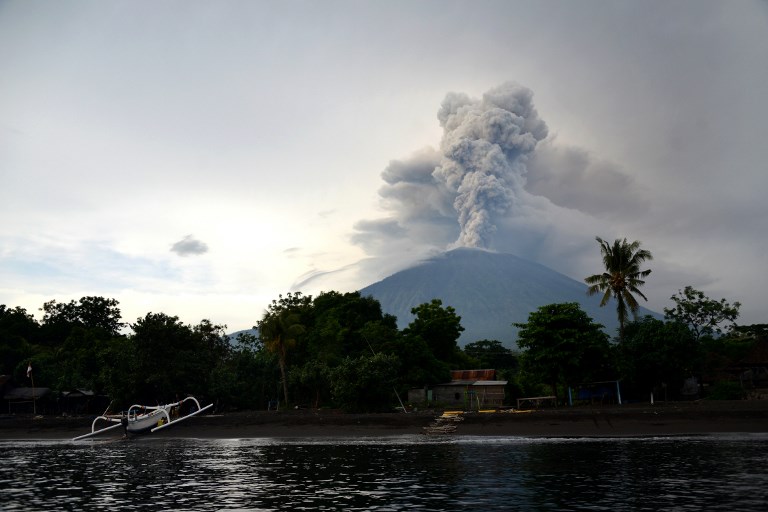Evacuation centers and hotels in Bali filled up Tuesday with tens of thousands seeking refuge as a larger eruption of a volcano on the Indonesian resort island threatened, forcing the closure of the main airport for a second day.
Stranded tourists hunted for accommodation while frightened villagers living in Mount Agung’s shadow made their way to more than 200 evacuation centers as the mountain gushed smoke and ash.
The rumbling volcano — which had its last major eruption in 1963 killing around 1,600 people — forced Indonesian authorities to close Bali’s airport for a second day Tuesday as experts raised the alert level to maximum.
Towering columns of thick gray smoke have been rising from the mountain since last week, and in the last few days have begun shooting into the sky, forcing all flights to be grounded until at least Wednesday morning.
Ash is dangerous for planes as it makes runways slippery and can be sucked into their engines.
Officials have warned that the volcano, which looms over the tropical holiday paradise, could give way to a larger eruption at any moment.
“The potential is there because magma is at the surface,” said Kasbani, the head of the country’s volcanology center, who like many Indonesians goes by one name.
Some 40,000 people have abandoned their homes in the danger zone but as many as many as 100,000 will likely be forced to leave, disaster agency officials have said.
“Volcanic ash is still spewing. It’s thick and rising very high — up to three or four kilometres from the crater,” said I Gede Suantika, an official at Indonesia’s volcanology agency.
The exclusion zone around Agung, which is 75 kilometers from the beachside tourist hub of Kuta, has also been widened to 10 kilometers.
As of Tuesday some 443 flights had been cancelled, affecting more than 120,000 passengers in Bali, a top holiday destination that attracts millions of foreign tourists every year.
“We are supposed to go back to Germany via Singapore on (Friday) but the situation seems not good,” said marooned student Alex Thamm.
“Is it dangerous here? Do you think [the volcano] will explode?”
‘Nobody’s fault’
Inn operator I Wayan Yastina Joni was among the few hoteliers willing to take up an appeal by Bali’s governor and tourism agency to supply free rooms to thousands of out-of-luck visitors, though some offered discounts.
“I don’t mind giving free accommodation for tourists I already know,” said the owner of the Pondok Denayu Homestay.
“This is nobody’s fault. It’s a natural disaster that no one expected,” he added.
Hundreds of tourists are being shuttled to Indonesia’s second largest city Surabaya, about 13 hours’ drive away, so they can fly out of the country.
“We are preparing 10 buses and more can likely be provided later today,” Bali Transportation Agency Head Agung Sudarsana said earlier Tuesday.
The airport on nearby Lombok island — also a popular tourist destination east of Bali — has opened and closed several times in the past few days. It is currently open but may yet be shuttered again, officials said.
Memories of disaster
Mount Agung’s last big eruption in the early sixties was one of the deadliest ever seen in a country with nearly 130 active volcanoes.
“I am very worried because I have experienced this before,” 67-year-old evacuee Dewa Gede Subagia, who was a teenager when Agung last roared, told AFP.
“I hope this time I won’t have to evacuate for too long. In 1963, I left for four months.”
Roadside signs that read “Volcanic danger zone. No entry!” underscored the potential risks of staying behind, although some evacuees had their doubts.
“The situation has forced us to be here,” said I Nyoman Taman.
“I don’t want to be here…because no matter how bad it is at home, it’s still better than at the evacuation center.”
Experts said however that Agung’s recent activity matches the build-up to the earlier disaster, which ejected enough debris — about a billion tons — to lower global average temperatures by 0.2 – 0.3 degrees Celsius for about a year.
“What we are seeing at the moment are small explosions, throwing out hot gases and fragments of molten rock, or ash,” said David Pyle, a volcano expert at Oxford University.
“The probability of a large eruption is high, but this may take some days or weeks to unfold.”
‘Ring of Fire’
Agung rumbled back to life in September, forcing the evacuation of 140,000 people living nearby. Its activity decreased in late October and many returned to their homes.
However, on Saturday the mountain sent smoke up into the air for the second time in a week in what volcanologists call a phreatic eruption — caused by the heating and expansion of groundwater.
Then on Monday so-called cold lava flows appeared — similar to mud flows and often a prelude to the blazing orange lava of the popular imagination.
Indonesia is the world’s most active volcanic region. The archipelago nation with over 17,000 islands lies on the Pacific “Ring of Fire” where tectonic plates collide, causing frequent volcanic and seismic activities.
Last year, seven people were killed after Mt. Sinabung on the western island of Sumatra erupted. A 2014 eruption at Sinabung killed 16.





Reader Interactions